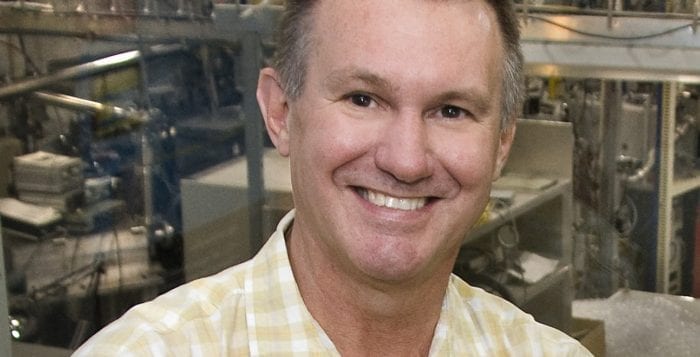Finding the ‘Needle’ for the Nuclear Waste Haystack
By Daniel Dunaief
Finding a proverbial needle in a haystack isn’t as hard as it once was. In fact, finding a needle with specific qualities has also become easier. Manufacturers and drug companies are constantly searching for a specific substance, whether it’s a drug that targets one part of an invading fungus or bacteria or a molecule that binds to a particularly harmful gas.
Indeed, it is in this latter category where John Parise, a distinguished research professor with joint appointments in geosciences and chemistry at Stony Brook University, and a team from Stony Brook, Brookhaven National Laboratory, the Lawrence Berkeley National Laboratory and Pacific Northwest National Laboratory recently shared their use of a metal organic framework, called SBMOF-1, that selectively binds to xenon, a gaseous by-product of nuclear reactions. Their findings, which were published recently in the journal Nature Communications, may point to a more effective and environmentally friendly way to manage nuclear waste.
“This [substance] is 70 times more effective than the current way scientists remove this dangerous gas,” said Parise, who has a joint appointment in photon sciences at BNL. “It allows krypton to pass through, but it retains xenon.” Parise said it acts like a sponge absorbing water until all the pores are filled, which can then be wrung out by passing a gas like nitrogen over it.
Researchers at Pacific Northwest National Laboratory, including Debasis Banerjee, who helped create this molecule when he was a graduate student at SBU, are continuing to work on this material.
The route SBMOF-1 took to becoming a potential xenon filter underscores the collaborative nature of a process that blends basic science with engineering, manufacturing, theory and potential commercial application.
Banerjee won the President’s Award as a distinguished doctoral student at Stony Brook for his research, which involved creating this framework in 2012. When Banerjee designed this material, he didn’t have xenon or nuclear energy on his mind — he was focused on trying to extract carbon dioxide at room temperatures in a humid environment during industrial processes. “We tested this material on numerous gases except xenon,” Parise said.
What they did that led to the next step, however, was critical to the search scientists at Berkeley were conducting to find their proverbial needle. The Berkeley researchers were looking for a better way to remove xenon from nuclear waste. The Stony Brook scientists put their compound in a searchable database online, which met the criteria the Berkeley scientists had established in their search.
Instead of trying to create something new, however, the Berkeley scientists did the equivalent of digging through massive piles of haystacks to search for something that already existed, perhaps for a different purpose, that might be a candidate for the job. Sure enough, they found SBMOF-1.
“While experimentally we need to sift through a fair amount of ‘hay’ — the computer, once programmed correctly (and this is nontrivial) works rapidly to locate the needle,” Parise said.
Indeed, when the theory met the reality, krypton passed through in 10 to 15 minutes, while xenon remained trapped for close to an hour. A nuclear facility can blow air back through the material and recover most of the xenon, Parise explained.
“It’s a beautiful compound and is so much better than anything else,” Parise said, although he cautioned that “it’s not to say something else can’t do better.”
In making the material, Bernjee started looking at sodium and calcium and phenyl ring compounds. He set out to create something that was environmentally friendly.
Banerjee is continuing to work on nuclear energy at PNNL. He reflected positively on his experiences at Stony Brook University, where he conducted research from 2007 to 2012. “Stony Brook is a great place to work, particularly for research,” he explained in an email. “I still actively collaborate with [Parise’s] group.”
He described Parise as a “great mentor” and said many of his current collaborators share a similar background of working in Parise’s lab. Banerjee’s scientific teammates are either in different national laboratories or are at other universities.
Parise is a strong advocate of the process that led to this uniting of theory and practice. This procedure will give the United States a research and development edge, because the theory makes the experiments more effective and the more effective experimental results reinforce the theory.
Parise works together with people like Artem Oganov, a professor in the Department of Geosciences at Stony Brook. They are exploring new compounds to split water from sunlight. “Computational materials discovery is an ongoing scientific revolution,” explained Oganov in an email. “Calculations are playing an increasingly critical role in materials science.”
Oganov said Parise is “known as a very creative and most versatile synthetic chemist.” Banerjee added that Parise “has major contributions in the field of materials characterization using X-ray and neutron diffraction.”
A native of North Queensland, Australia, Parise started working at SBU in 1989. He is married to Alyse Parise, who is a business coach and psychotherapist, who has a private practice in Setauket. Residents of Poquott, the Parises enjoy the beaches and kayaking on Long Island. At the end of July, they will join friends to raft down the Salmon River in Idaho.
As for his work, Parise said he is dedicated to determining how the structure of compounds are arranged. “We’re interested in where the atoms are” in a wide range of materials, he said.







